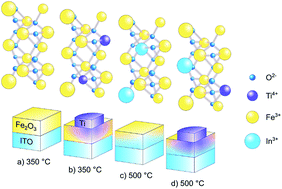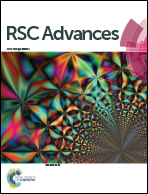Synergies of co-doping in ultra-thin hematite photoanodes for solar water oxidation: In and Ti as representative case†
Abstract
Solar energy induced water splitting in photoelectrochemical (PEC) cells is one of the most sustainable ways of hydrogen production. The challenge is to develop corrosion resistant and chemically stable semiconductors that absorb sunlight in the visible region and, at the same time, have the band edges matching with the redox level of water. In this work, hematite (α-Fe2O3) thin films were prepared onto an indium-doped tin oxide (ITO; In:SnO2) substrate by e-beam evaporation of Fe, followed by air annealing at two different temperatures: 350 and 500 °C. The samples annealed at 500 °C show an in situ diffusion of indium from the ITO substrate to the surface of α-Fe2O3, where it acts as a dopant and enhances the photoelectrochemical properties of hematite. Structural, optical, chemical and photoelectrochemical analysis reveal that the diffusion of In at 500 °C enhances the optical absorption, increases the electrode–electrolyte contact area by changing the surface topology, improves the carrier concentration and shifts the flat band potential in the cathodic direction. Further enhancement in photocurrent density was observed by ex situ diffusion of Ti, deposited in the form of nanodisks, from the top surface to the bulk. The in situ In diffused α-Fe2O3 photoanode exhibits an improved photoelectrochemical performance, with a photocurrent density of 145 μA cm−2 at 1.23 VRHE, compared to 37 μA cm−2 for the photoanode prepared at 350 °C; it also decreases the photocurrent onset potential from 1.13 V to 1.09 V. However, the In/Ti co-doped sample exhibits an even higher photocurrent density of 290 μA cm−2 at 1.23 VRHE and the photocurrent onset potential decreases to 0.93 VRHE, which is attributed to the additional doping and to the surface becoming more favorable to charge separation.



 Please wait while we load your content...
Please wait while we load your content...